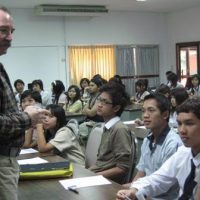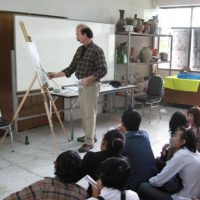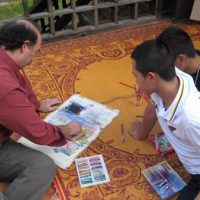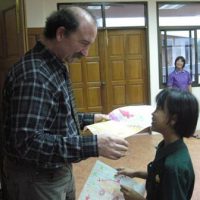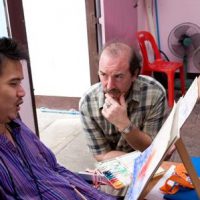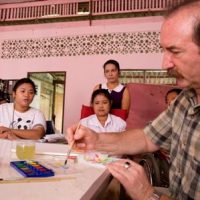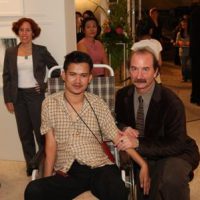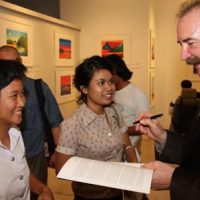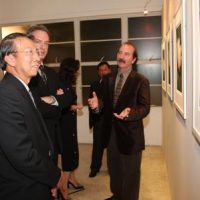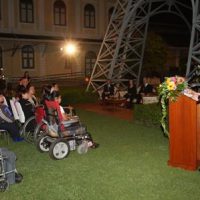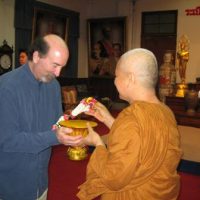John Domont’s visit to Thailand on behalf of ART in Embassies was marked by his outreach into Thai society. He lectured, taught and demonstrated throughout the country for ten days from November 17, 2008 to November 26, 2008 at seven universities as well as an Islamic high school. He also held workshops for disabled adults, orphaned children and children living with HIV.
Throughout his lectures, Domont expressed the belief that American art explores the diversity of its culture and that it also reflects the needs of society. These beliefs are evident in the diversity of his artistic production, which ranges from landscape photography to Buddhist alms bowls. Domont found that the Thai people who attended his workshops and lectures readily embraced these ideals and were interested in creating art that reflected the needs of their own society.
CLAIRE: (Speaking Thai)
CLAIRE: Mr. John Domont from America, welcome to Morning World. DOMONT: My pleasure, thank you.
CLAIRE: So, John, what brings you here?
DOMONT: Well, Claire, I’m lucky enough to come as part of American Artists Abroad, it’s a program from my government which has two parts. The Art in Embassies program where the ambassador to a particular country can decorate their embassy and receiving areas in the fashion that they are interested in and his excellency Ambassador John is from Indiana and chose some of my art to decorate the embassy and then I was awarded this position, American Artist Abroad, which is a program started in 1964 by our government and is outreach really our government trying to say here is our ideas and lets have some interchange and some friendship and exchange some aesthetic points of view as well.
CLAIRE: Well this has been very beneficial for especially Thai students who receives for an artist from America, I think. So, what does it give you, personally?
DOMONT: This is the most tremendous experience. I find the Thai people very generous in their hearts and very receptive in their minds and it’s a chance to really give the greatest depth that I have and it’s a chance to help them with perhaps some ideas that they haven’t been exposed to before so that they might have better lives as artists and individuals.
CLAIRE: I know it’s hard to define art but what is art to you?
DOMONT: To me art is that which reflects the best of human values, all human values, really, but good art is about human value, good art is that which helps me learn who I am and where I am and in relation to other human beings, what are we together? What is this world, what is this time?
CLAIRE: You started off with photography and then moved on to painting. What are the differences?
DOMONT: Great differences. Photography is a moment, photography is an expression of light and color and movement and shape that’s right now. And it’s a frozen moment in a way, even though that frozen moment can reflect a greater unity to something beyond the right now. Painting is a chance to give color and shape and technique to the depth of your soul. Painting is also a voyage of discovery. Photography is as well, but I think it’s a longer process. Paintings take up to two months.
CLAIRE: Wow. So you’ve got different subject matters, waterlilies, landscape, a bowl, how do you select those subject matters?
DOMONT: Some of it’s the time of year and the crops are coming and what do the fields look like because I love nature so much. My offering and receiving bowl paintings come to me in dreams or
meditation and I paint them when they arrive. You never know when a poem will come. I think life is an art of listening, for us to have good lives, for us to have emotional balance, mental balance and a sort of spiritual journey we need to learn to listen to ourselves and listen to life. I think that’s my message as much as anything as an artist, what do we have in common and what is this moment and how do I receive it and how do I show gratitude for the journey.
CLAIRE: Have you ever received critiques about your work and how do you deal with it?
DOMONT: So far, knock on wood, I haven’t received any bad reviews, you know? And artists are always very sensitive and worried about what the public thinks of them and what the press thinks of them and I think I’ve gotten to the point in life where I’m just concerned with going on with the work and giving the best of what I have to give. You give the gift of love, you can never really control the outcome nor should you worry about controlling the outcome. You give your gift in the best way possible and hopefully it’s received in the best way possible.
CLAIRE: (Speaking Thai)
CLAIRE: So you’ve had a lecture with the kids today, basically, what are you trying to communicate, what are you trying to tell them about art?
DOMONT: A lot. I’m trying to share some technique but I’m also trying to teach the idea of whole brain thinking. In art there is technique and there is imagination and life is a flow back and forth between structure and idea, color, concept and how to achieve it. But I’m also trying to teach something more and that’s how to feel, perceive and access the inspiration of your life. Inspiration is something more important than imagination and more important than technique. Inspiration is that thing that guides each of us, individually, though our lives. This is language that’s not necessarily taught in school, it’s the language of the right brain, it’s poetic language, it’s the language of color, it’s the language of imagination. If the imagination is tied to the person’s heart and mind, if it’s tied to if they find the way to contact themselves and know what inspires them and know what makes them feel good and know individually each student, each person, what gives them love, then they have the chance to go on this journey throughout their life.
CLAIRE: But that’s the most difficult part. When I look at the piece of work, an artwork, sometimes it’s frustrating because you don’t know what the artist is trying to communicate. How can we start, people who are beginners, who begin to look at art?
DOMONT: I think it’s, you don’t have to get too complicated about it. You see what you see and you feel what you feel and you trust that. You can’t have understanding without some relationship to feeling. Sometimes if an artist is process oriented, gluing and nailing and adding materials together, it is a piece of art for itself, it’s own closed-in idea. Sometimes a piece of art will be in the circle of someone’s imagination without having a bigger human inspiration of teaching us about ourselves and each other. And not every piece of art is equal. Nietzsche, the western philosopher said, for a piece of art to be great, it has to be about gratitude, it has to have gratitude in its notion.
CLAIRE: Your work includes a lot of lighting, playing with lighting. How does that bring out the message that you are trying to communicate?
DOMONT: Lighting is both a reality and a tool. There’s the light of nature, there’s inspirational light, and then there’s the surface light of the materials itself. And I think I’ve studied and worked hard to learn what other artists have done in the past so that I might become a contemporary painter, a painter of the now and be able to give something perhaps that hasn’t been given before.
CLAIRE: Artists in the old days, they painted outdoors as well as indoors. Do you paint outdoors as well? DOMONT: I do, I do.
CLAIRE: Is that why you travel a lot?
DOMONT: I travel also to receive inspiration, culture, and ideas from around the world because I don’t know very much. I’m always trying to learn, you know? But yes, the early landscape painters, the plein air painters from before starting with Jean-Francois Millet and the Barbizon school in France in the 1850s and 60s then grew into the impressionists and post impressionists and this was a time when photography was being born and the science of light and film and black and white pictures were being born. So that kind of painting has a lot to do with the moment like photography has a lot to do with the moment. It brought us great paintings into the world and many people still try to imitate that style. I’ve tried to go on beyond that and talk about the contemporary moment, now what does life feel like and what are the results of the abstract expressions how do art and life keep growing. I think you have to be true and respectful to good artists from before but also have to integrate and know that but go on. And that’s what I’ve tried to do.
CLAIRE: What’s your future project? Any future project?
DOMONT: Well, that’s a deep question, Claire. Time will tell. I do always love the landscape because I do love being outdoors and I do love nature, nature is the guide, nature is the living moment. I’m really interested in drawing people and painting people and the human journey is the next phase of my work to talk about what it is, who it is, who we are in common. I’ve started a couple of projects here in Thailand through teaching that I’m interested in pursuing and we’ll see, I guess.
CLAIRE: Well, John, thank you very much for your time today.
DOMONT: My pleasure, thank you, Claire.
